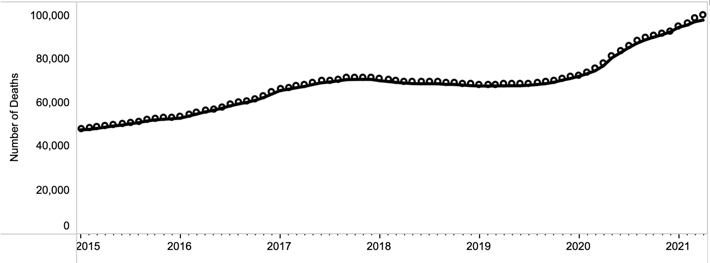Over 100,000 Lives Lost to Drugs; CDC Finalizes Overdose Fatalities for 2020

Recent headlines across the nation and world announced that, for the first time since official recording began, the United States suffered more than 100,000 drug overdose deaths in one 12 month period. And not only were drug overdose fatalities 28% higher in 2020 than in 2019, but fentanyl deaths alone in 2020 were higher than all drug-related deaths combined in 2016.
This is a sobering moment. It is a call to action for families to get educated and informed on the drug addiction epidemic. And for families who have a loved one who is using drugs or alcohol, this grim moment is a call to action for those families to do everything within their power to get their loved ones into addiction treatment centers as soon as possible.
Uncovering the Problem
According to the Centers for Disease Control and Prevention, from April 2020 to April 2021, approximately 100,306 Americans died from drug overdoses. That number, shocking and discouraging as it is, is expected to go up still further as CDC researchers complete their analysis of toxicology reports for that period. The number reflects a significant increase in drug-related deaths over April 2019 to April 2020 (78,056 deaths during that period), and it reflects a steady, ongoing increase in drug overdoses which has been consistent since the late-1990s.

The CDC data is concerning, and it’s getting national and international coverage given the dire condition of America’s addiction crisis. One Guardian reporter noted that fentanyl has become the major factor in America’s drug crisis, with fentanyl substances being mixed into methamphetamine, cocaine, and other opioids to create particularly deadly drug cocktails.
“This is a symptom of broader dysfunction in the U.S. pharmaceutical industry, where public health concerns are secondary to financial concerns.”
The Guardian also reported that life-saving emergency-use medications like naloxone are becoming increasingly scarce and expensive in the U.S., making it more difficult for responders and citizens to save the lives of overdosing addicts. Nonprofit and volunteer groups that would normally buy naloxone from Pfizer and create life-saving kits for their communities for $2.50 per kit now have to pay anywhere from $37-$75 per kit. Quoting Leo Beletsky, a professor of law and health sciences at Northeastern University, “To put it in stark terms, you could be saving one life or you could be saving 10 lives for the same price.” He went on to say, “This is a symptom of broader dysfunction in the U.S. pharmaceutical industry, where public health concerns are secondary to financial concerns.”
Fentanyl Defined; America’s #1 Addictive, Lethal Drug

One of the factors that has led to such a dramatic surge in overdose deaths is that the drug supply is much deadlier, primarily due to increasingly widespread synthetic opioids like fentanyl. Fentanyl is an extremely potent drug, ten times more potent than heroin and 100 times more potent than morphine. And without addicts knowing, fentanyl is being mixed with other drugs, further spreading fentanyl out into the drug supply.
Fentanyl is so potent that its only intended use is for closely-supervised treatment of chronic, severe pain or acute, severe pain following surgery. According to the Drug Enforcement Administration, fentanyl should only be used under extremely limited circumstances. Even then, patients who are prescribed it should be monitored closely for fentanyl misuse.
Legitimately prescribed fentanyl being diverted or abused is one problem. An even bigger problem is illicit, illegally-trafficked fentanyl. Quoting DEA warnings about this new drug, “Illicit fentanyl, primarily manufactured in foreign clandestine labs and smuggled into the United States through Mexico, is being distributed across the country and sold on the illegal drug market… Because there is no official oversight or quality control, these counterfeit pills often contain lethal doses of fentanyl, with none of the promised drug.” Undoubtedly, drug-related deaths in the U.S. will continue to increase as long as illicit fentanyl is made, trafficked, sold, and used by addicts.
Lack of Access to Treatment is Also a Lethal Factor
There is no doubt that addiction treatment saves lives. When addicts don’t have access to treatment, they are at a much higher risk of overdosing and dying. While the 2020 COVID-19 pandemic by itself certainly exacerbated conditions for addicts, the pandemic also caused many other conditions to worsen. For example, addicts had less access to treatment than usual due to an overburdened healthcare system and simply too few addiction treatment centers to meet the needs of the millions of Americans who are now hooked on drugs and alcohol.
“This is a momentous tragedy hidden by the pandemic. It’s heartbreaking how many families have been affected by an overdose this year.”
A Reuters reporter interviewed an expert on the access to treatment factor, uncovering the fact that the pandemic sorely exacerbated an already serious problem in American healthcare and treatment accessibility for addicts. Quoting Dr. Joshua Sharfstein, director of the American Health Initiative at the Johns Hopkins Bloomberg School of Public Health, “This is a momentous tragedy hidden by the pandemic. It’s heartbreaking how many families have been affected by an overdose this year.” He went on to say, “A lot of (drug addiction) programs had to close or reduce their hours or otherwise become less accessible during the pandemic. So even as there was much more need, there was less access to care in many places.”
As long as addicts consume mind-altering and increasingly dangerous, potentially lethal drugs and as long as they do not have access to treatment centers that can help them get clean, addicts will continue to experience overdoses, many of which will be lethal.
Keep Track of Your Loved Ones; Time Spent Alone Contributed to a Spike in Overdoses

A third factor, a unique factor, also contributed to an almost 30% spike in overdose deaths from April 2020 to April 2021. The COVID-19 pandemic caused significant isolation in American communities all across the nation. This led to addicts being more likely to use drugs alone. When an addict uses substances alone, particularly opioid substances, they are more likely to experience a fatal overdose.
An addict who uses drugs in a group of people may survive an overdose, as someone nearby may observe the overdose and provide emergency medical care. But an addict who uses alone will have no one there to help if they overdose.
Now More Than Ever, Families Must Work Together to Get Their Loved Ones into Treatment
Drug addiction is a life or death crisis, perhaps now more so than ever before. American families need to know the signs and symptoms of drug abuse. They need to know what to look for, and they need to be mindful of their loved ones’ health and wellbeing. Experimenting with drugs and alcohol can quickly become a life or death crisis, necessitating an immediate response from family members.
If you know someone who is addicted to drugs, don’t let them go another day without getting help. Don’t let them become just another statistic. Please reach out to a drug and alcohol rehab center today.
Sources:
- https://www.cdc.gov/nchs/nvss/vsrr/drug-overdose-data.htm
- https://www.theguardian.com/society/2021/nov/17/us-drug-overdose-deaths-increase-cdc
- https://www.dea.gov/resources/facts-about-fentanyl
- https://www.reuters.com/world/us/us-drug-overdose-deaths-top-100000-annually-cdc-2021-11-17/
Reviewed by Claire Pinelli; ICAADC, CCS, LADC, RAS, MCAP, LCDC


 ®
®